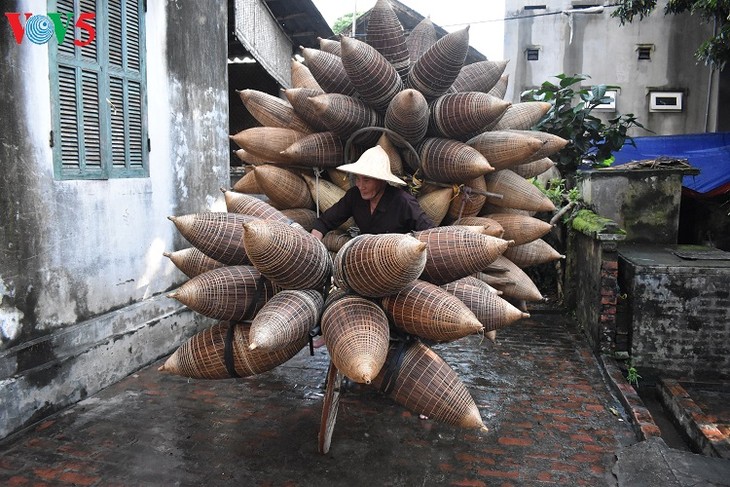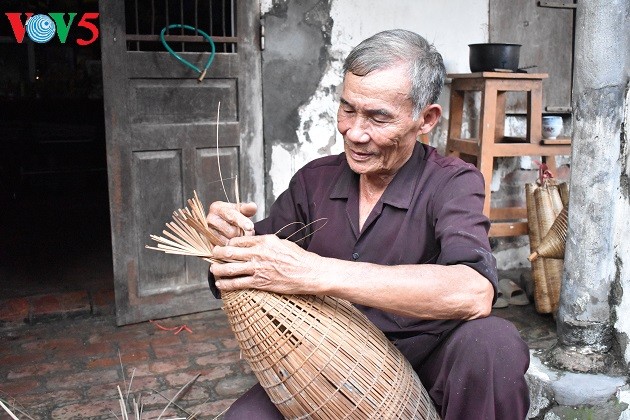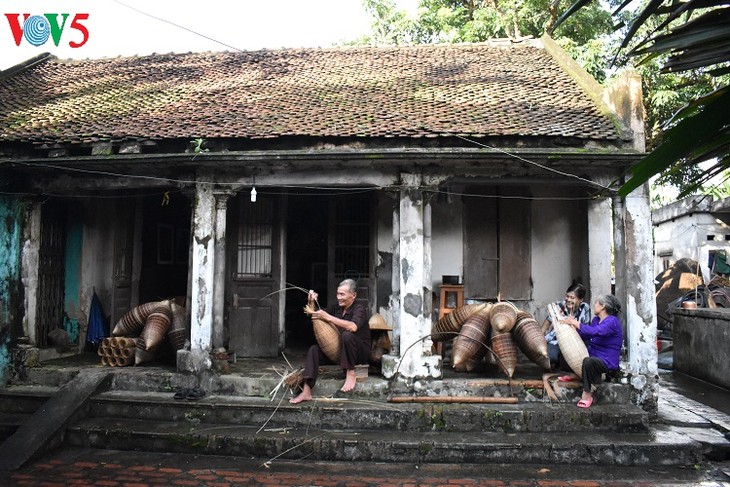(VOVWORLD) - A fish-pot is a traditional fishing tool to catch fish used mainly in Vietnam’s northern delta provinces. Thu Sy village in Hung Yen province is famous for its traditional job of weaving fish pots. Thu Sy products are sold throughout the northern region and exported to other countries.

Elder Luong Son Bac has travelled nationwide by his legendary bike to promote Thu Sy traditional craft of weaving fish-pots. (Photo: Lan Anh/VOV5)
|
Located 60 km from Hanoi, Thu Sy village is characterized by dark brown tiled roofs, 3-room houses, and rows of bamboo trees.
Some 500 people still pursue the craft which has long been associated with the communes of Noi Lang and Tat Vien.
Village elder Nguyen Thi Dan told VOV that Thu Sy residents first learned the job more than 2 centuries ago, adding: "The village’s tutelary god is Ms. Nguyen Thi Hue who passed down the craft of fish-pot weaving. We make both fish pots and shrimp nets."
Strolling through the village, you will see elders sitting in front of their house, weaving fish-pots and chatting. In the leisure following harvest time, they weave fish-pots all day long. But before the harvest, they weave only at night.

Villager Dao Thanh Mien (Photo: Lan Anh/VOV5)
|
Villager Dao Thanh Mien says the craft requires skill and meticulous care. "In Thu Sy village, even little kids and old people make bamboo products. We begin to learn how to weave pots when we were 5 years old," Mien said.
Fish-pots are made from old bamboo which is split and whittled into even, thin laths of different sizes manually.
Weaving fish-pots requires patience and a love for the craft. Finished products are put on a smoking-shelf and smoked them to enhance their durability.
 Elder Luong Son Bac (Photo: Lan Anh/VOV5) Elder Luong Son Bac (Photo: Lan Anh/VOV5) |
Elder Luong Son Bac who is famous in Thu Sy said: “A proper fish-pot should be woven smoothly and smoked with straw until it is dark brown. The split laths must be dried and then dipped in limewater. A beautiful pot should be smoked 3 times. Smoking is the most difficult step. Female elders often do this step the best."
Each year Thu Sy supplies about 650,000 products to nearby provinces like Ha Nam, Nam Dinh, Bac Ninh, and Bac Giang which have sunken rice fields and many ditches, canals, and rivers. A fish-pot costs between 200,000 and 400,000 Vietnamese dong – less than 2 USD. Though it is a part-time job, weaving fish-pots brings in half of local income.
According to Bac, "In the past, villagers used to weave fish-pots at night and sell them in the market the next morning to earn enough money for their children to attend school. I did the same. Now I earn some dozens of USD a month, which is enough to live on. Thanks to weaving fish-pots, my children have grown up."
Today fish-pots are no longer in wide use. That doesn’t mean the craft has fallen into oblivion, though fish-pots are now sold as works of fine art or decorative items for home in Vietnam as well as in the US, Singapore, Japan, and India.
 Villagers weave fish-pots at Bac’s house. (Photo: Lan Anh/VOV5) Villagers weave fish-pots at Bac’s house. (Photo: Lan Anh/VOV5)
|
Village elder Bac said: "if you put a light in the fish-pot, it looks very beautiful. Customers from the US and many other countries like them very much. Indian resellers have recently signed contracts with us.”
On sunny days in Thu Sy village bamboo fish-pots filled with flowers decorate the courtyard of each house. Visitors like us can meet the friendly locals and try our own hand at weaving a fish-pot.